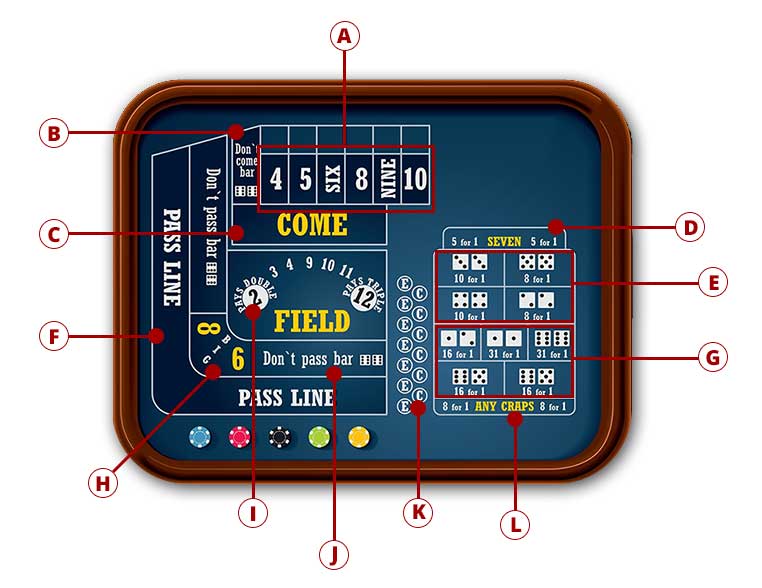How to Play Craps
Sometimes known just as “dice”, craps is an exciting game which has kept casino lovers entertained for generations and is still a favourite today, as players take to the tables to make bets on how the dice will roll.
The game is played using two dice and takes place on a specially designed table encircled by a small rubberised wall. The table is laid out with a felt cloth and marked out with different sections which denote the various betting options available. Players make wagers by placing chips on the corresponding section or having their chips put there by the dealer.
Around each craps table there are typically four members of staff. Two dealers are responsible for all bets made on their half of the table, a boxman supervises events and a stickman controls the dice, using a flexible stick to move the dice towards the next player.
Craps Table Layout

- APlace Bets
- BDont Come Bet
- CCome Bet
- DAny 7 Bet
- EHard Ways Bet
- FPass Line Bet
- GOne Roll Bet
- HBig 6/8 Bet
- IField Bet
- JDon't Pass Line Bet
- KHorn Bet
- LAny Craps
There are lots of different wagers that can be made, and the table might seem complicated to new players, but it is more straightforward than it initially appears. The main bet to be aware of is the Pass Line bet, which happens when a new player takes their turn at rolling the dice. Whoever throws the dice is known as the shooter and their first go is termed a ‘Come Out’ roll. If the shooter throws a 7 or 11, the Pass Line bet wins, whereas if they throw a 2, 3 or 12, the Pass Line bet loses. It is also possible to bet on ‘Don’t Pass’, where the reverse applies and you lose if the first roll is 7 or 11.
A 4, 5, 6, 7, 8, 9 or 10 is known as establishing a point, and players can then start to bet on whether the shooter will make their point or not. Once a point has been established, a Come bet can be made which works in the same way as a Pass Line bet. The player will keep rolling until they throw the same number again and pass (or win), or throw a 7 (and lose). The same player will carry on rolling as long as they continue to make winning rolls.
Throw a 7 or 11 on the Come Out roll, or throw the point twice before a 7.
Throw a 2, 3 or 12 in the Come Out roll, or throw a 7 before hitting the point for a second time.
Etiquette
A craps table can be the most raucous area of a casino, as players can all win rather than compete against each other or play one-on-one with the dealer. For that reason, there is nothing wrong with getting excited and cheering with the shooter, as long as you don’t get too carried away. Betting against the shooter has a similar house edge, but players generally prefer to stick together and bet on Pass Line or Come. If you bet against the shooter, you miss out on the sense of camaraderie that can build around the table and may be seen as the enemy, especially if you are quite vocal, so it is best to keep a low profile if you do decide to bet this way. Other tips on etiquette include:
- Respect the dealer. Place your chips down neatly and tidily and don’t hurl them around so that the dealer is slowed down. Don’t try to place bets when the shooter already has the dice in their hands.
- Keep your hands off the table and out of the way of the dice that are being thrown. You do not want to disrupt the game by altering the toss because your hands got in the way!
- If you are the shooter, toss the dice across the table. Throwing them hard so they bounce off the back walls may offend other players or casino staff.
- Handle dice with one hand and make sure not to hide the dice at any stage. Again, it slows the game down, as the dealer or boxman will grow suspicious and may want to inspect the dice.
- Learn the lingo. There are nicknames for all the possible combinations of dice, such as Snake Eyes (1 and 1), Hard Four (2 and 2) and Boxcars (6 and 6).
Strategy
The issue of controlled shooting has been debated through the years, as there are occasions when players do consistently roll the same number and go on hot streaks. Craps fans may try to perfect a method where they grip the dice in the same way and try to throw them the same every time, but it is best to view each roll of the dice as producing a random outcome, and so it is important to understand dice odds as you consider your strategy.
A pair of dice can produce 36 possible combinations, and the odds on craps are based on the chances of each event happening. For example, while a total of two can only be made one way (1 and 1), a total of three can be made two ways (1 and 2, 2 and 1) and a total of seven can be made up six ways (6 and 1, 1 and 6, 5 and 2, 2 and 5, 4 and 3, 3 and 4). Seven is the number that can be made the most different ways.
Sticking to Pass Line betting is not a bad strategy, particularly for beginners, but players can then go on to ‘take the odds’, which has no house edge. For example, if the established point is a 6 or 8, you can bet that this number will be rolled again before a 7. Statistically a 7 is more likely to be thrown so players are paid out at true odds of 6 to 5. If the point is a 4 or 10, the odds are even better at 2:1. It is a good idea to place the maximum allowed bet on the odds, which varies between casinos but may be two, three or four times the size of your Pass Line bet, depending on the point.
Proposition bets generally have the highest house edge of all craps wagers and are best avoided. They are disguised as a fun way to make a different type of wager and do offer some big rewards, but the odds are against you. For example, you can bet on Any Seven being thrown next at a payoff of 4:1, but the odds are actually 5:1. Throwing Snake Eyes (2) or Boxcars (12) is a 35:1 chance, but the house will only pay out 30:1.
Field bets, which are one-off wagers that the next roll will be 2, 3, 4, 9, 10, 11 or 12, can also appear quite tempting. A player will win at a payout of 1:1 if a 3, 4, 9, 10 or 11 is thrown, and will lose if a 5, 6, 7 or 8 is rolled. The odds are that a 5, 6, 7 or 8 will be rolled and it may only be worth considering a Field bet if the payout on 2 or 12 is at least 3:1.
Important Terms:
All craps combinations have their own nicknames, and can be remembered as below:
- 1-1 Snake Eyes, Two Aces
- 1-2 Ace Deuce, Ace Caught a Deuce
- 1-3 Easy Four
- 1-4 Fever Five, No Field Five
- 1-5 Easy Six, Jimmy Hicks
- 1-6 Natural, Six Ace
- 2-2 Hard Four
- 2-3 Fever Five, No Field Five
- 2-4 Easy Six, Jimmy Hicks
- 2-5 Natural
- 2-6 Easy Eight
- 3-3 Hard Six, Jimmy Hicks
- 3-4 Natural
- 3-5 Easy Eight
- 3-6 Nina
- 4-4 Hard Eight, Square Pair
- 4-5 Nina, Jesse James
- 4-6 Easy Ten
- 5-5 Hard Ten, Puppy Paws
- 5-6 Yo’leven
- 6-6 Boxcars, Midnight
Visit the Casino Glossary for more terms which you might find in craps or other casino games.
